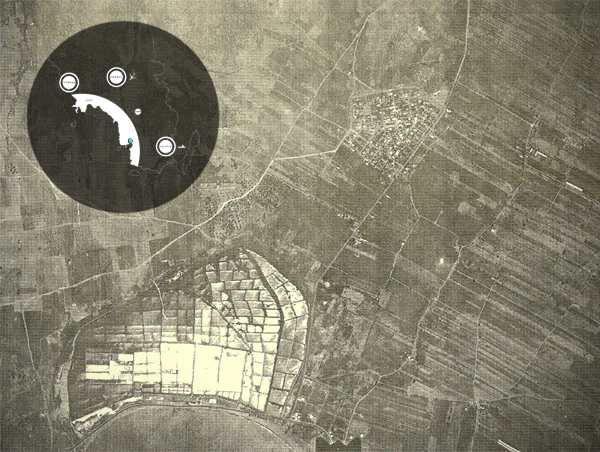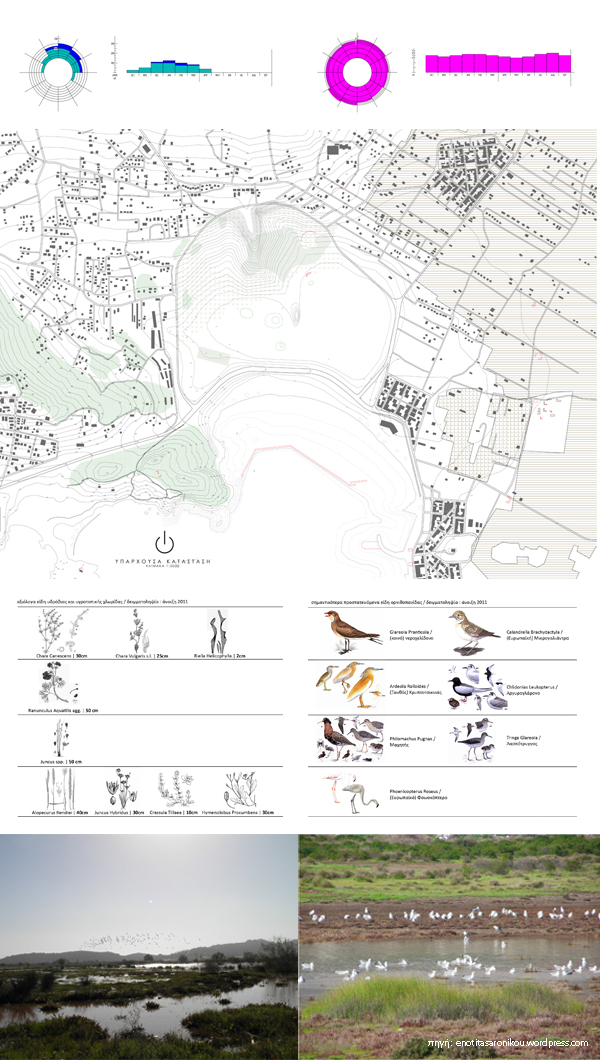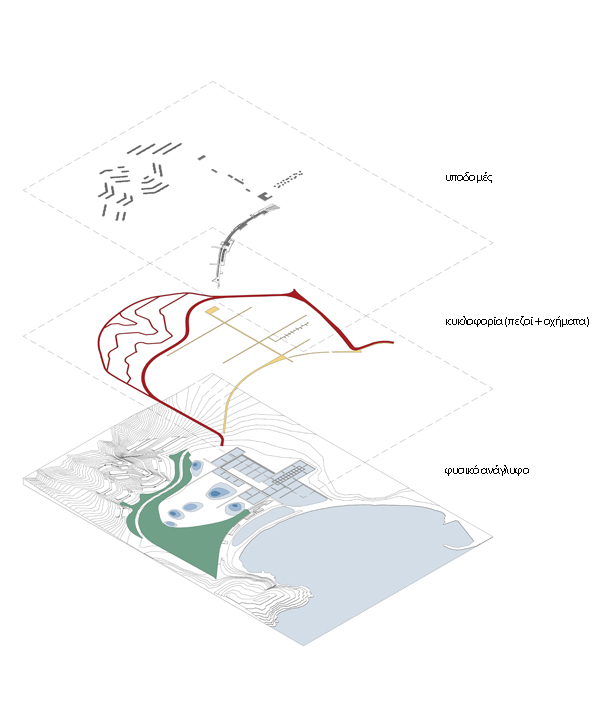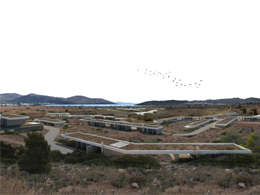STUDENTS PROJECTS
PROJECTS2013
Student : Leonidas Kalpaxidis
Supervisor : Panos Dragonas
University of Patras, Department of Architecture
Presentation date : 30 October 2014
The project takes place in Anavyssos, a coastal region in South Attica. The place had been inhabited from classic and archaic times, composing the ancient Athenian Deme of Anaphlystos. Several centuries later, two wide groups of refugees from Asia Minor settled in Anavyssos after 1922. Nevertheless, the main urban development occurred during the late 20th century, when Anavyssos became a recreation suburb for Athenians.
The area is located at the edge of a basin, created by local mountains. The land relief is separated in two diverse parts, a level one (ex-saline), south and a sloping one, north. An artificial arc-shaped soil bank, in parallel with the coastline, sustains the waterside avenue.

There is an interesting relation between Alykes and water. During periods of high rain level, plenty of streams conclude there, while sea water was always being collected during winter and evaporated gradually until summer, due to geomorphology and lower-than-sea level.
The diversity of the land relief results in the variation of soil quality and multiple landscape types. In the south, the argillaceous ground in addition to the operation of the old saline evoked rare alophytic flora growth. The north section is rocky and covered by typical Attica vegetation, while neighbouring pine-tree woodland tends to expand from in it. According to the Hellenic Ornithological Society, Alykes constitute a unique station for rare species of emigrant birds in south Attica.

The area's analysis concluded the highly problematic situation caused by the devitalisation of the landscape natural forces, combined with the lack of facilities. The soil bank contributed to the isolation of the field and cease the water cycle, undermining the alophytic ecosystem. Additionally, the soil pollution decreases the pine trees growth in the north section.
Considering these problems, the proposal intends to reactivate the latent landscape forces, establish a new, diverse program and, mainly, focus on the co-existence and interaction between these two factors.
The proposal's elements are being divided and analysed in layers in order to organize the program's complexity. The landscape interpretations are designed on the first layer, the pedestrian and vehicle circulations network on the second and the buildings on the third.

The three types of land relief are differently manipulated in order to contain new facilities. Firstly, the east part of the soil bank is removed and sea water enters the field again, while a new accommodation unit is developed lengthwise. A salt tank system is designed along the level surface of Alykes, in order to collect and organise the sea water. After all, the recreation houses undercut the north sloping part.
Time played a basic role during the project design. The landscape of Alykes and the balance between its forces transform during the years and also periodically, during the seasons. Considering the principles of Landscape Urbanism, the project is not aiming on a final master plan. It is analysed instead, in three phases of a total duration of 30 years, allowing future adjustments to the new data. The landscape relations develop flexibly, without being disturbed by human operation.
In Phase One (0-5 years), the proposal aims to configure the new balances and to prepare the field for the new program. Polluted spots get land filled, the ground gets sanitized, new vegetation is planted and the circulation network is developed. Simultaneously, the avenue moves northern, while the accommodation unit is completed, in order to fund the continuity and guarantee the sustainability of the project. Finally, the construction of the settlement begins.
During Phase Two (5-15 years), the Baths and the Salt Spa Centre are taking place. The ecosystem develops normally, supported by new vegetation and protected from human facilities. The "new ground" on the north expands.
In Phase Three (15-25 years), the "new ground" with the recreation residences is completed. All the public buildings (Museum, Environmental Centre, etc.) in the field get constructed and the landscape continues to develop and transform.

On the next stage, the proposal focuses on three zoom-ins: the accommodation unit, the landscape mechanism of salt production and the holiday residences settlement.
The first zoom-in refers to the accommodation unit. The avenue moves northern, while the accommodation and the promenade are established on the soil bank. As a result, the new facilities do not affect the alophytic ecosystem of Alykes, but they utilize an artificial infrastructure.
The building is divided in three levels. The lower one includes the unit's common uses, the internal vehicular circulation and parking. The middle level includes living spaces and the unit's internal circulation. The top level becomes a public space for walking and cycling. Horizontally, the unit splits into two volumes. The west volume is linked with water sports and the type of the rooms refers to the Cycladic waterfront fishmen houses type called "sirmata". In this type, living rooms are found on the upper level, while boats park on the lower. The east and main volume is constituted by 52 rooms of 3 types, a conference hall with an amphitheatre and multi-purpose rooms. Moreover, platforms are located in the area in front of the accommodation unit and host ephemeral uses and water sports. Finally, the promenade provides the experience of an elevated waterside walk, connecting the Palaia Fokea marine with the St. Nicolas path.

Secondly, the project zooms-in on the area of the ex-saline. The alophytic formations system spreads organically, while a canonical salt tank system develops, based on the old saline's grid. In the middle of the field, the two diverse systems conflict and a second promenade emerges.
The importation of the sea water in Alykes benefits both landscape and human, as the wetland is supported and the salted water and salt are utilized for medicinal purposes. Water flows due to gravity and pump's operation between salt tanks, gradually concentrating and converting into salt. The final product falls from a platform into the subterranean salt spa.
A wooden stake network of bungalows is constructed along the second salt tank. Each of them provides a private bath of local stone, while the main volume includes outdoor as well as internal public baths.
The pedestrian who uses the promenade enjoys the experience of balancing between two diverse systems, informs himself about the history and folklore of Anavyssos in the Museum, observes the wetland from the Environmental Center, interacts with multiple salt production operations, crosses the waterfront promenade and concludes at the shore.

The third zoom-in refers to the settlement of the recreation residences. A set of elongated concrete surfaces, covered with local vegetation, harmonizes the topography and creates sheltered unities of 3 to 5 residences, directed to the sea, shaping a "new ground". In addition, groups of walls bore into the land relief in order to support the surfaces and organize interior and semi-open spaces. The wooden deck of each residence splits in two levels, creating interesting multi-height spaces and providing privacy without separating surfaces.













